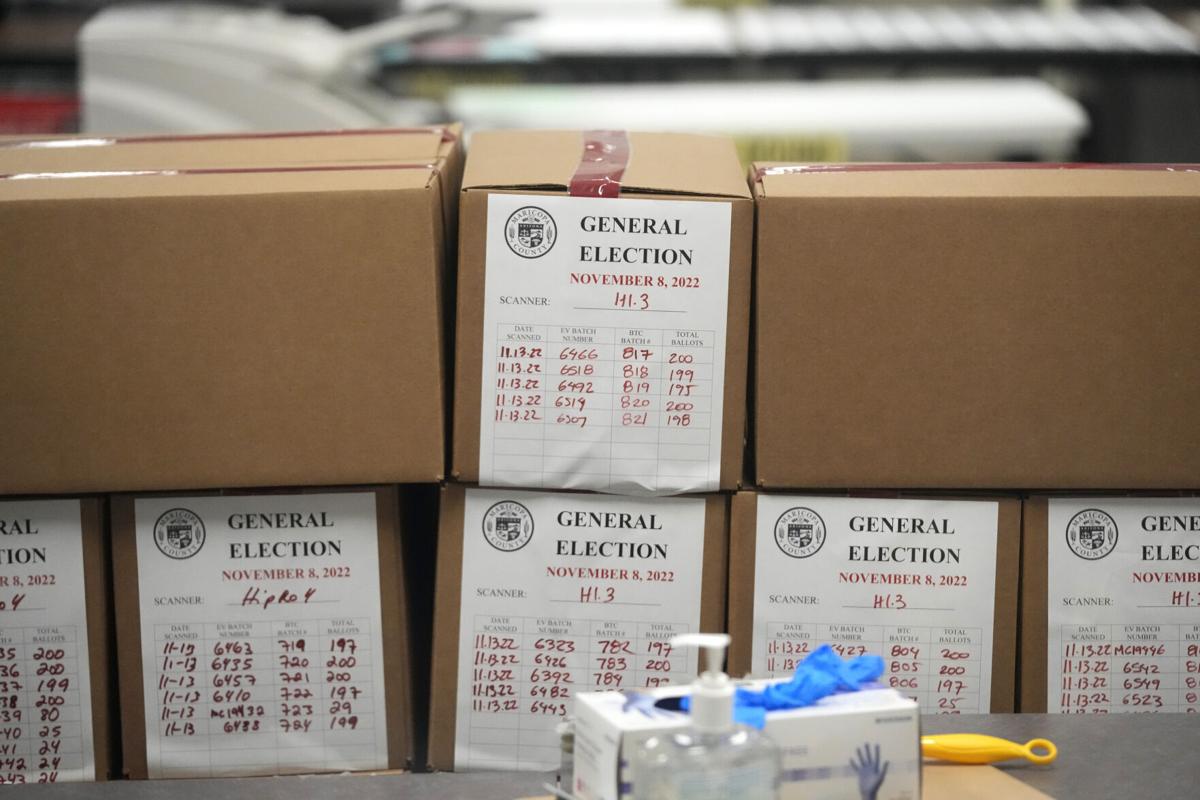PHOENIX — Election Day issues at numerous vote centers run by Maricopa County in November’s election were the result of equipment failures and not caused by human error or an intentional act, a new report concludes.
The report released by the county on Monday was written by Ruth McGregor, a former chief justice of the Arizona Supreme Court who was hired by the county. She investigated problems that helped lead to long lines at some polling places after on-site ballot tabulators were unable to read some voters’ completed ballots.
The county had traced the problem to printers at about 60 of the county’s 223 vote centers that failed to produce ballots that could be read by the tabulators. Under the system, ballots that match the specific races on each voter’s ballot are printed when the person checks in, are filled out by the voter and then placed by them in a vote-counting machine.
But on Nov. 8, more than 6% of the ballots were rejected by the vote center tabulators, leading to confusion, angry voters and a scramble by county election officials, their contractors and technicians to try to fix the issue. Although the efforts were partly successful, the issues continued throughout the day.
McGregor concluded that it was indeed one of two types of printers the county used that was the root cause of the problem.
The Oki brand printers were overwhelmed by a combination of factors, including a change to a heavier weight of paper and a larger ballot needed to handle all the candidates’ names and ballot measures on the general election ballot.
Lake’s campaign blasts report
The report counteracts contentions by an expert hired by losing Republican governor’s candidate Kari Lake.
A tweet sent from Lake’s official campaign account blasted the report.
“We told you this was a farce,” the tweet said.
“These people don’t think your vote or your opinion matters,” it continued. “And anyone who takes the results of this ‘investigation’ seriously is part of the problem.”
Maricopa County spokesman Fields Moseley said McGregor was completely independent and was able to find out what caused the problems.
“This was not an internal investigation,” Moseley said. “This was an outside person who hired her own people and came in and looked at a sample of our printer and ran tests, thousands and thousands of ballots through those printers.”
The same printers were used without issue in August’s primary election, albeit with different paper stock and a 19-inch-long ballot.
“Although separating related causes is always difficult, in my judgment, the primary cause of the election day failures was equipment failure,” McGregor wrote. “Despite the assurances of the manufacturer, many of the Oki B432 printers were not capable of reliably printing 20-inch ballots on 100-pound paper under election-day conditions.”
The issues affected ballots cast by nearly 17,000 voters on Nov. 8, or 6.7% of the more than 248,000 people who voted in person on Election Day.
All of those ballots were counted after being taken to the county’s central tabulation center, and no voters lost their right to vote.
But the issue was key to Lake’s election challenge.
She lost to Democratic Gov. Katie Hobbs and sued in an effort to overturn the election. Her lawsuit was dismissed by a trial court judge and nearly all his findings were upheld by the Arizona Supreme Court.
Lake and her attorneys contended that at least some of the problems with the printers were intentional and intended to cost her the election by discouraging Republicans, who vote in person more frequently than Democrats, from casting their ballots.
During the trial Clay Parikh, testifying for Lake, said some of the general election ballots were printed out to just 19 inches in length, leaving excess area along the borders, and making them unreadable to on-site tabulators programmed to read 20-inch ballots.
“Is there any way, in your opinion, for a 19-inch ballot image to be projected onto a 20-inch ballot by accident?” asked Lake attorney Kurt Olson.
“No, sir,” Parikh responded. “The settings and configurations and the procedures that are used cannot allow that,” he continued. “These are not a ‘bump up against the printer and the settings change.’”
But the trial judge said that didn’t matter.
“Plaintiff’s own expert acknowledged that a ballot that was unable to be read at the vote center could be deposited by a voter, duplicated by a bipartisan board onto a readable ballot, and — in the final analysis — counted,” Judge Peter Thompson write in his December ruling.
McGregor was unable to find out how that happened.
“We could not determine whether this change resulted from a technician attempting to correct the printing issues, the most probable source of change, or a problem internal to the printers,” the retired judge wrote in her report.
Report recommends series of changes
McGregor did recommend a series of changes, including potentially replacing all of the Oki printers, moving to thinner paper, or counting all ballots at the county’s central processing site. The last two could be problematic, delaying results in one case and potentially leading to “bleed-through” of ink in the second.
Ink that bled through to the other side of the ballot triggered a dust-up in 2020 dubbed “Sharpie-Gate” after some people thought the ink could mark a vote on the opposite side of the ballot. That’s not possible, since the ovals to be marked by voters are off set from those on the opposite side.
While the Arizona Supreme Court upheld most of Thompson’s ruling, the justices did agree to give Lake the chance to argue that the county followed an improper process to verify signatures on early ballot envelopes. That portion of the case was returned to the trial court for further actions.
Get your morning recap of today's local news and read the full stories here: http://tucne.ws/morning





